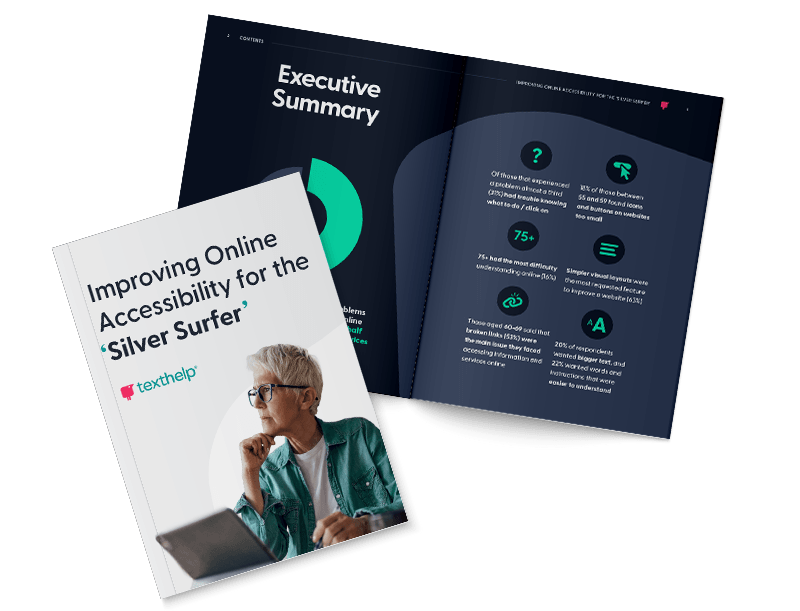Improving Online Accessibility for the older web user
A research paper by Texthelp, together with YouGov, exploring the online experiences of those aged 50+ throughout the COVID-19 pandemic.
Needless to say the COVID-19 pandemic has changed many aspects of our lives. As the physical world locked-down, many organisations were forced to go 'digital by default'. But how accessible were the online experiences of their website visitors, to both avid and new digital users?
Recent data from the Office for National Statistics found that recent internet users over 75 has nearly doubled since 2013, from 29%, to 54% in 2020. In this report, we uncover their online successes and challenges.
To make our findings more representative and informative, we also explored the experiences of all age groups over 50. We found that 1 in 4 faced problems accessing products and services online during lockdown.
In this report, we explore why and how accessibility should be addressed for this large demographic, across every industry.
Register to receive the report.
In this report:
- Gain insight into the most common accessibility barriers faced
- Discover what this means for your industry, and gain advice from accessibility leaders in the finance, healthcare, government and retail sectors
- Uncover a blueprint for making your online channels accessible - from your website, to your social media platforms and beyond

With thanks to our friends and fellow accessibility advocates for their input and insights into this paper.

A short summary
YouGov in partnership with Texthelp conducted a study to discover the online experiences of those aged 50 and over throughout the COVID-19 pandemic. Respondents were members of the YouGov Plc UK panel. Panelists were selected at random from a base sample, and invited to take part in an online interview process. The survey, conducted in April 2021, sourced responses from 2,031 individuals aged 50 and over.
Results found that 1 in 4 aged over 50 have faced problems accessing products and services online during lockdown.
Usability problems were experienced across healthcare, retail, financial and public service websites.
Of those that experienced an accessibility barrier:
- Almost a third (31%) had trouble knowing what to do or click on
- Over one in ten (12.5%) faced issues with broken links
- 63% felt that simpler visual layouts would improve a website
- 20% said that bigger text would be preferred
- 22% wanted words and instructions that were easier to understand
Without tackling this problem of online accessibility, we risk leaving those who experience challenges ‘locked out’ of critical services. With an ageing population, and public and private companies predominantly ‘digital-first’, online accessibility matters - across every industry.
As we look to the future, accessibility must be prioritised. Especially given that over half of respondents (56%) plan to continue using online services as much as they did during lockdown.
- Almost a third (30.93%) will continue to use online services for accessing healthcare
- Almost two thirds (64%) will continue to access banking or financial tools digitally
- 40% will continue to access information from their local authority online
- Almost a third (31%) will continue to buy groceries online
- 44% will continue to browse and buy lifestyle goods online
Organisations need to make sure that digital accessibility is a focus. Removing barriers to usability means making sure that the user experience is simple and enjoyable. As well as making sure that content is easy to understand.
In this report hear first hand about the online experiences of those aged over 50. Discover the most common accessibility barriers faced. And explore how to address accessibility for this growing demographic, across every industry.
